Simulation of Urban Carbon Sequestration Service Flows and the Sustainability of Service Supply and Demand
Abstract
1. Introduction
2. Materials and Methods
2.1. Study Area
2.2. Data
2.3. Methods
2.3.1. Interpolation of Wind Directions
Calculate the Resistance Coefficient
The Least-Cost Path (LCP) Analysis
Interpolation of Prevailing Wind Directions
2.3.2. Interpolation and Correction of Wind Speed
Interpolation of Wind Speed
Topographic Correction
Surface Correction
2.3.3. Carbon Emission Accounting and Spatialization
Carbon Emission Accounting
Spatialization of Carbon Emissions
- (a)
- Based on the intensity of human activities at different POIs, weights are assigned using the analytic hierarchy process (Table S5). The kernel density estimation results of the POIs are then computed to derive the POI energy consumption factor (ECF) based on these weights.
- (b)
- The road network is categorized into expressways, main roads, secondary roads, and other roads. Weights of 2.39, 1.96, 1.30, and 1.00 are assigned based on the width of each road grade, while railways are weighted at 4.07 [62]. The kernel density estimation of the road traffic ECF is calculated based on assigned weights.
- (c)
- The energy consumption factors are normalized. Given that POIs encompass carbon emissions from both production activities and daily life, the POI ECF is assigned a weight of two-thirds (2/3), whereas the transportation ECF is given a weight of one-third (1/3). The comprehensive ECF is derived from the weighted sum of these two. A masking process is then employed using the extent of the built-up areas, and the carbon emissions within these zones are spatialized using the following equation:
2.3.4. Quantify “Instantaneous” ECSS Flow
3. Results
3.1. Simulation of Wind Directions
3.2. Wind Speed Interpolation and Correction
3.3. Carbon Emission Accounting and Spatialization
3.4. ECSS Flow
4. Discussion
4.1. Impact of Air Inlet Position Changes on ECSS Flows
4.2. Sustainability of ECSS Supply and Demand
4.3. Evaluation of the Method and Limitations of Its Application
4.4. Policy Recommendations
5. Conclusions
Supplementary Materials
Author Contributions
Funding
Institutional Review Board Statement
Informed Consent Statement
Data Availability Statement
Conflicts of Interest
Abbreviations
| AAWS | Annual average wind speed |
| CNBH | Chinese building height |
| ECSS | Ecosystem carbon sequestration services |
| ES | Ecosystem services |
| ECF | Energy consumption factor |
| DEM | Digital Elevation Model |
| JAWS | July average wind speed |
| LST | Land surface temperature |
| LCP | Least-cost path |
| POIs | Points of interest |
References
- Costanza, R.; d’Arge, R.; Groot, R.d.; Farber, S.; Grasso, M.; Hannon, B.; Limburg, K.; Naeem, S.; O’Neill, R.; Paruelo, J.; et al. The value of the world’s ecosystem services and natural capital. Ecol. Econ. 1998, 25, 3–15. [Google Scholar] [CrossRef]
- Tao, Y.; Tao, Q.; Sun, X.; Qiu, J.X.; Pueppke, S.G.; Ou, W.X.; Guo, J.; Qi, J.G. Mapping ecosystem service supply and demand dynamics under rapid urban expansion: A case study in the Yangtze River Delta of China. Ecosyst. Serv. 2022, 56, 101448. [Google Scholar] [CrossRef]
- Bryan, B.A.; Ye, Y.; Zhang, J.; Connor, J.D. Land-use change impacts on ecosystem services value: Incorporating the scarcity effects of supply and demand dynamics. Ecosyst. Serv. 2018, 32, 144–157. [Google Scholar] [CrossRef]
- Fisher, B.; Turner, R.K.; Morling, P. Defining and classifying ecosystem services for decision making. Ecol. Econ. 2009, 68, 643–653. [Google Scholar] [CrossRef]
- Jones, L.; Norton, L.; Austin, Z.; Browne, A.L.; Donovan, D.; Emmett, B.A.; Grabowski, Z.J.; Howard, D.C.; Jones, J.P.G.; Kenter, J.O. Stocks and flows of natural and human-derived capital in ecosystem services. Land Use Policy 2016, 52, 151–162. [Google Scholar] [CrossRef]
- Liu, H.; Liu, L.; Ren, J.; Bian, Z.; Ding, S. Progress of quantitative analysis of ecosystem service flow. Chin. J. Appl. Ecol. 2017, 28, 2723–2730. [Google Scholar]
- Schirpke, U.; Candiago, S.; Vigl, L.E.; Jäger, H.; Labadini, A.; Marsoner, T.; Meisch, C.; Tasser, E.; Tappeiner, U. Integrating supply, flow and demand to enhance the understanding of interactions among multiple ecosystem services. Sci. Total Environ. 2019, 651, 928–941. [Google Scholar] [CrossRef]
- Ecosystems and Human Well-Being: Synthesis. Available online: https://www.millenniumassessment.org/documents/document.356.aspx.pdf (accessed on 20 April 2024).
- Zang, Z.; Zou, X.-Q. Connotation characterization and evaluation of ecological well-being based on ecosystem service theory. Chin. J. Appl. Ecol. 2016, 27, 1085–1094. [Google Scholar]
- Wang, Z.; Zhang, L.; Li, X.; Li, Y.; Frans, V.F.; Yan, J. A network perspective for mapping freshwater service flows at the watershed scale. Ecosyst. Serv. 2020, 45, 101129. [Google Scholar] [CrossRef]
- Gao, X.; Huang, B.; Hou, Y.; Xu, W.; Zheng, H.; Ma, D.; Ouyang, Z. Using ecosystem service flows to inform ecological compensation: Theory & application. Int. J. Environ. Res. Public Health 2020, 17, 3340. [Google Scholar] [CrossRef]
- Zhao, Y.; Wu, F.; Li, F.; Chen, X.; Xu, X.; Shao, Z. Ecological compensation standard of trans-boundary river basin based on ecological spillover value: A case study for the Lancang–Mekong River Basin. Water 2021, 18, 1251. [Google Scholar] [CrossRef] [PubMed]
- Su, K.; Sun, X.; Guo, H.; Long, Q.; Li, S.; Mao, X.; Niu, T.; Yu, Q.; Wang, Y.; Yue, D. The establishment of a cross-regional differentiated ecological compensation scheme based on the benefit areas and benefit levels of sand-stabilization ecosystem service. Int. J. Environ. Res. Public Health 2020, 270, 122490. [Google Scholar] [CrossRef]
- Wang, T.; Piao, S. Estimate of terrestrial carbon balance over the Tibetan Plateau: Progresses, challenges and perspectives. Quat. Sci. 2023, 43, 313–323. [Google Scholar]
- Li, T.; Li, J.; Wang, Y. Carbon sequestration service flow in the Guanzhong-Tianshui economic region of China: How it flows, what drives it, and where could be optimized? Ecol. Indic. 2019, 96, 548–558. [Google Scholar] [CrossRef]
- Wu, J.; Fan, X.; Li, K.; Wu, Y. Assessment of ecosystem service flow and optimization of spatial pattern of supply and demand matching in Pearl River Delta, China. Ecol. Indic. 2023, 153, 110452. [Google Scholar] [CrossRef]
- Liang, J.; Pan, J. Identifying carbon sequestration’s priority supply areas from the standpoint of ecosystem service flow: A case study for Northwestern China’s Shiyang River Basin. Sci. Total Environ. 2024, 927, 172283. [Google Scholar] [CrossRef]
- Xu, Z.; Wei, H.; Fan, W.; Wang, X.; Zhang, P.; Ren, J.; Lu, N.; Gao, Z.; Dong, X.; Kong, W. Relationships between ecosystem services and human well-being changes based on carbon flow—A case study of the Manas River Basin, Xinjiang, China. Ecosyst. Serv. 2019, 37, 100934. [Google Scholar] [CrossRef]
- Yang, J.; Li, J.; Guan, X. Spatio-Temporal Pattern and Driving Mechanism of Ecosystem Carbon Sequestration Services in the Wujiang River Basin. Res. Environ. Sci. Res. Environ. Sci. 2023, 36, 757–767. [Google Scholar]
- Hong, W.; Bao, G.; Du, Y.; Guo, Y.; Wang, C.; Wang, G.; Ren, Z. Spatiotemporal changes in supply–demand patterns of carbon sequestration services in an urban agglomeration under China’s rapid urbanization. Remote Sens. 2023, 15, 811. [Google Scholar] [CrossRef]
- Wu, C.; Lu, R.; Zhang, P.; Dai, E. Multilevel ecological compensation policy design based on ecosystem service flow: A case study of carbon sequestration services in the Qinghai-Tibet Plateau. Sci. Total Environ. 2024, 921, 171093. [Google Scholar] [CrossRef]
- Wang, Q.; Liu, S.; Wang, F.; Liu, H.; Liu, Y.; Yu, L.; Sun, J.; Tran, L.-S.P.; Dong, Y. Quantifying carbon sequestration service flow associated with human activities based on network model on the Qinghai-Tibetan. Front. Environ. Sci. 2022, 10, 900908. [Google Scholar] [CrossRef]
- Liu, W.; Zhan, J.; Zhao, F.; Zhang, F.; Teng, Y.; Wang, C.; Chu, X.; Kumi, M.A. The tradeoffs between food supply and demand from the perspective of ecosystem service flows: A case study in the Pearl River Delta, China. J. Environ. Manag. 2022, 301, 113814. [Google Scholar] [CrossRef] [PubMed]
- Zhai, T.; Wang, J.; Fang, Y.; Huang, L.; Liu, J.; Zhao, C. Integrating ecosystem services supply, demand and flow in ecological compensation: A case study of carbon sequestration services. Sustainability 2021, 13, 1668. [Google Scholar] [CrossRef]
- Qin, K.; Liu, J.; Yan, L.; Huang, H. Integrating ecosystem services flows into water security simulations in water scarce areas: Present and future. Sci. Total Environ. 2019, 670, 1037–1048. [Google Scholar] [CrossRef]
- Bagstad, K.J.; Villa, F.; Batker, D.; Harrison-Cox, J.; Voigt, B.; Johnson, G.W. From theoretical to actual ecosystem services: Mapping beneficiaries and spatial flows in ecosystem service assessments. Ecol. Soc. 2014, 19, 64. [Google Scholar] [CrossRef]
- Guo, F.; Zhang, H.; Fan, Y.; Zhu, P.; Wang, S.; Lu, X.; Jin, Y. Detection and evaluation of a ventilation path in a mountainous city for a sea breeze: The case of Dalian. Build. Environ. 2018, 145, 177–195. [Google Scholar] [CrossRef]
- He, Y.; Liu, Z.; Ng, E. Parametrization of irregularity of urban morphologies for designing better pedestrian wind environment in high-density cities–A wind tunnel study. Build. Environ. 2022, 226, 109692. [Google Scholar] [CrossRef]
- Chen, L.; Lu, J.; Yu, W. A quantitative method to detect the ventilation paths in a mountainous urban city for urban planning: A case study in Guizhou, China. Indoor Built Environ. 2017, 26, 422–437. [Google Scholar] [CrossRef]
- Xu, Y.; Wang, W.; Chen, B.; Chang, M.; Wang, X. Identification of ventilation corridors using backward trajectory simulations in Beijing. Sustain. Cities Soc. 2021, 70, 102889. [Google Scholar] [CrossRef]
- Xu, Y.; Wan, X.; Fu, C.; Liu, C. Study of wind speed interpolation in complex terrain—A case of Jilin Province. Front. Earth Sci. 2012, 24, 78–81. [Google Scholar]
- Qi, Y. Vector interpolation of wind fields over complex terrain. Radialization Prot. 2001, 21, 213–218. [Google Scholar]
- Shi, T.; Yan, Y.; Wang, L.; Wang, Z. Large − Scale Wind Speed Simulation Based on DEM. Geogr. Geo-Inf. Sci. 2007, 23, 26–29. [Google Scholar]
- Amaral, S.; Câmara, G.; Monteiro, A.M.V.; Quintanilha, J.A.; Elvidge, C.D. Estimating population and energy consumption in Brazilian Amazonia using DMSP night-time satellite data. Comput. Environ. Urban Syst. 2005, 29, 179–195. [Google Scholar] [CrossRef]
- Elvidge, C.D.; Baugh, K.E.; Kihn, E.A.; Kroehl, H.W.; Davis, E.R.; Davis, C.W. Relation between satellite observed visible-near infrared emissions, population, economic activity and electric power consumption. J. Remote Sens. 1997, 18, 1373–1379. [Google Scholar] [CrossRef]
- Wu, J.; Niu, Y.; Peng, J.; Wang, Z.; Huang, X. Research on energy consumption dynamic among prefecture-level cities in China based on DMSP/OLS Nighttime Light. Geographical Research. Geogr. Res. 2014, 33, 625–634. [Google Scholar]
- Zhang, X.; Zhao, T.; Xu, H.; Liu, W.; Wang, J.; Chen, X.; Liu, L. GLC_FCS30D: The first global 30 m land-cover dynamic monitoring product with a fine classification system for the period from 1985 to 2022 generated using densetime-series Landsat imagery and the continuous change-detection method. Earth Syst. Sci. Data 2024, 16, 1353–1381. [Google Scholar] [CrossRef]
- Wu, W.-B.; Ma, J.; Banzhaf, E.; Meadows, M.E.; Yu, Z.-W.; Guo, F.-X.; Sengupta, D.; Cai, X.-X.; Zhao, B. A first Chinese building height estimate at 10 m resolution (CNBH-10 m) using multi-source earth observations and machine learning. Remote Sens. Environ. 2023, 291, 113578. [Google Scholar] [CrossRef]
- Jiang, X.; Ming, X.; Zhang, J.; Zhang, S.; Zhang, S. Distribution Characteristics and Exploitation and Utilization of Wind Energy Resources of Shenyang City, China. Resour. Sci. 2009, 31, 1764–1771. [Google Scholar]
- Gong, Q.; Wang, H.; Zhu, L.; Lin, N.; Gu, Z.; Chao, H.; Xu, H. Study on the Near SurfaceWind Shear Characteristics in Liaoning Province. J. Nat. Resour. 2015, 30, 1560–1569. [Google Scholar]
- Mihailović, D.; Lalić, B.; Rajković, B.; Arsenić, I. A roughness sublayer wind profile above a non-uniform surface. Bound. -Layer Meteorol. 1999, 93, 425–451. [Google Scholar] [CrossRef]
- Yue, T.; Wang, W.; Yu, Q.; Zhu, Z.; Zhang, S.; Zhang, R.; Du, P. Simulation of Vertical Wind Profile and Its Relevant Parameters under Neutral Condition. Resour. Sci. 2006, 28, 136–144. [Google Scholar]
- Zhang, Y.; Shen, X. Simulation Analysis of Vegetation Covered Surface’s Aerodynamics Roughness Length and Zero Displacement. J. Desert Res. 2008, 28, 21–26. [Google Scholar]
- Li, J.; You, S.; Huang, J. Spatial distribution of ground roughness length based on GIS in China. J. Shanghai Jiaotong Univ. (Agric. Sci.) 2006, 24, 185–189. (In Chinese) [Google Scholar]
- Li, Q.; Cai, X.; Song, Y. Research of the distribution of national scale surface roughness length with high resolution in China. Plateau Meteorol. 2014, 33, 474–482. [Google Scholar]
- Kang, L.; Yang, Z.; Zhang, J.; Zou, X.; Wen, Z. Wind tunnel simulation for comparison of wind velocity profile characteristics at two flexible plant surfaces. J. Desert Res. 2020, 40, 43. [Google Scholar]
- Jasinski, M.F.; Crago, R.D. Estimation of vegetation aerodynamic roughness of natural regions using frontal area density determined from satellite imagery. Agric. For. Meteorol. 1999, 94, 65–77. [Google Scholar] [CrossRef]
- Garratt, J.R. The atmospheric boundary layer. Earth-Sci. Rev. 1994, 37, 89–134. [Google Scholar] [CrossRef]
- Burian, S.; Brown, M.; Augustus, N. Development and assessment of the second generation National Building Statistics database. In Proceedings of the Seventh Symposium on the Urban Environment, San Diego, CA, USA, 11 September 2007. [Google Scholar]
- Yue, T.X.; Wang, W.; Yu, Q.; Zhu, Z.; Zhang, S.H.; Zhang, R.H.; Du, Z. Simulation of vertical wind profile under neutral conditions. International J. Remote Sens. 2007, 28, 2207–2219. [Google Scholar] [CrossRef]
- Lettau, H. Note on aerodynamic roughness-parameter estimation on the basis of roughness-element description. J. Appl. Meteorol. 1969, 8, 828–832. [Google Scholar] [CrossRef]
- Qiao, Z.; Xu, X.; Wu, F.; Luo, W.; Wang, F.; Liu, L.; Sun, Z. Urban ventilation network model: A case study of the core zone of capital function in Beijing metropolitan area. J. Clean. Prod. 2017, 168, 526–535. [Google Scholar] [CrossRef]
- Shen, X.; Zhao, R.; He, R.; Wang, Q.; Guo, Y. Research on Urban Wind Environment Simulation: A Case Study of Zhengzhou Central Area. J. Geo-Inf. Sci. 2020, 22, 1349–1357. [Google Scholar]
- Wong, M.S.; Nichol, J.E.; To, P.H.; Wang, J. A simple method for designation of urban ventilation corridors and its application to urban heat island analysis. Build. Environ. 2010, 45, 1880–1889. [Google Scholar] [CrossRef]
- Xu, W.; Zhang, L.; Qi, L.; Liu, D.; Zhang, S.; Cao, D. Observation Analysis of the Influence of Surface Wind on Urban Heat Island in Shanghai. Meteorological Monthly J. Appl. Meteorol. Climatol. 2019, 45, 1262–1277. [Google Scholar]
- Huang, Q.; Lu, Y. Long-term Trend of Urban Heat Island Intensity and Climatological Affecting Mechanism in Bejing City. Sci. Geogr. Sin. 2018, 38, 1715–1723. [Google Scholar]
- Alonso, M.; Fidalgo, M.; Labajo, J.L. The urban heat island in Salamanca (Spain) and its relationship to meteorological parameters. Clim. Res. 2007, 34, 39–46. [Google Scholar] [CrossRef]
- Zhou, S.; Shu, J. Urban Climatology; Meteorological Press: Beijing, China, 1994; ISBN 7–5029–1645–8. [Google Scholar]
- Bornstein, R. Observed urban-rural wind speed differences in New York City. In Proceedings of the AGU National Fall Meeting, San Francisco, CA, USA, 15–18 December 1969. [Google Scholar]
- Ma, X.; Wang, Z. Progress in the study on the impact of land-use change on regional carbon sources and sinks. Acta Ecol. Sin. 2015, 35, 5898–5907. [Google Scholar]
- Sun, X. Effects of carbon emission by land use patterns in Hefei’s economic circle of Anhui province. Resour. Ecol. 2012, 27, 394–401. [Google Scholar]
- Fu, B.; Zhai, J.; Xu, Y.; Zhao, B.; Xie, X.; Xue, B. Mapping urban-rural energy consumption pattern based on the POl data: A case study of Weifang City, Shandong Province. J. Earth Environ. 2023, 14, 774–785. [Google Scholar] [CrossRef]
- Janzen, H. Carbon cycling in earth systems—a soil science perspective. Agric. Ecosyst. Environ. 2004, 104, 399–417. [Google Scholar] [CrossRef]
- The Carbon Cycle and Atmospheric Carbon Dioxide. Available online: https://hal.science/hal-03333974/document (accessed on 3 September 2021).
- Cortinovis, C.; Geneletti, D. A framework to explore the effects of urban planning decisions on regulating ecosystem services in cities. Ecosyst. Serv. 2019, 38, 100946. [Google Scholar] [CrossRef]
- Lourdes, K.T.; Hamel, P.; Gibbins, C.N.; Sanusi, R.; Azhar, B.; Lechner, A.M. Planning for green infrastructure using multiple urban ecosystem service models and multicriteria analysis. Landsc. Urban Plan. 2022, 226, 104500. [Google Scholar] [CrossRef]
- Syrbe, R.-U.; Walz, U. Spatial indicators for the assessment of ecosystem services: Providing, benefiting and connecting areas and landscape metrics. Ecol. Indic. 2012, 21, 80–88. [Google Scholar] [CrossRef]
- Pulselli, F.M.; Coscieme, L.; Bastianoni, S. Ecosystem services as a counterpart of emergy flows to ecosystems. Ecol. Model. 2011, 222, 2924–2928. [Google Scholar] [CrossRef]
- Ren, C.; Yuan, C.; Ho, C.K.; Ng, Y.Y. A Study of Air Path and Its Application in Urban Planning. Urban Plan. Forum 2014, 3, 52–60. (In Chinese) [Google Scholar]

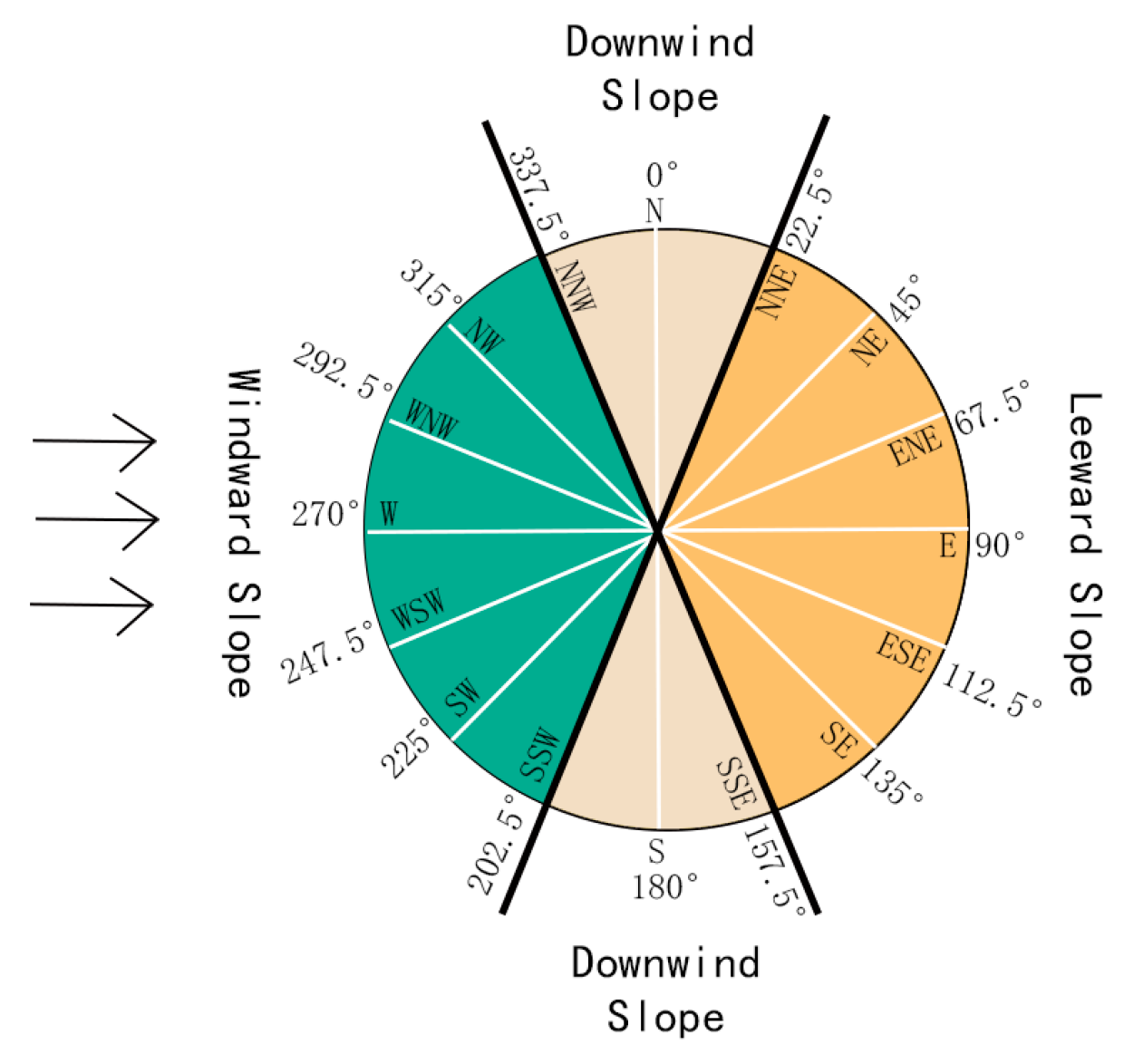
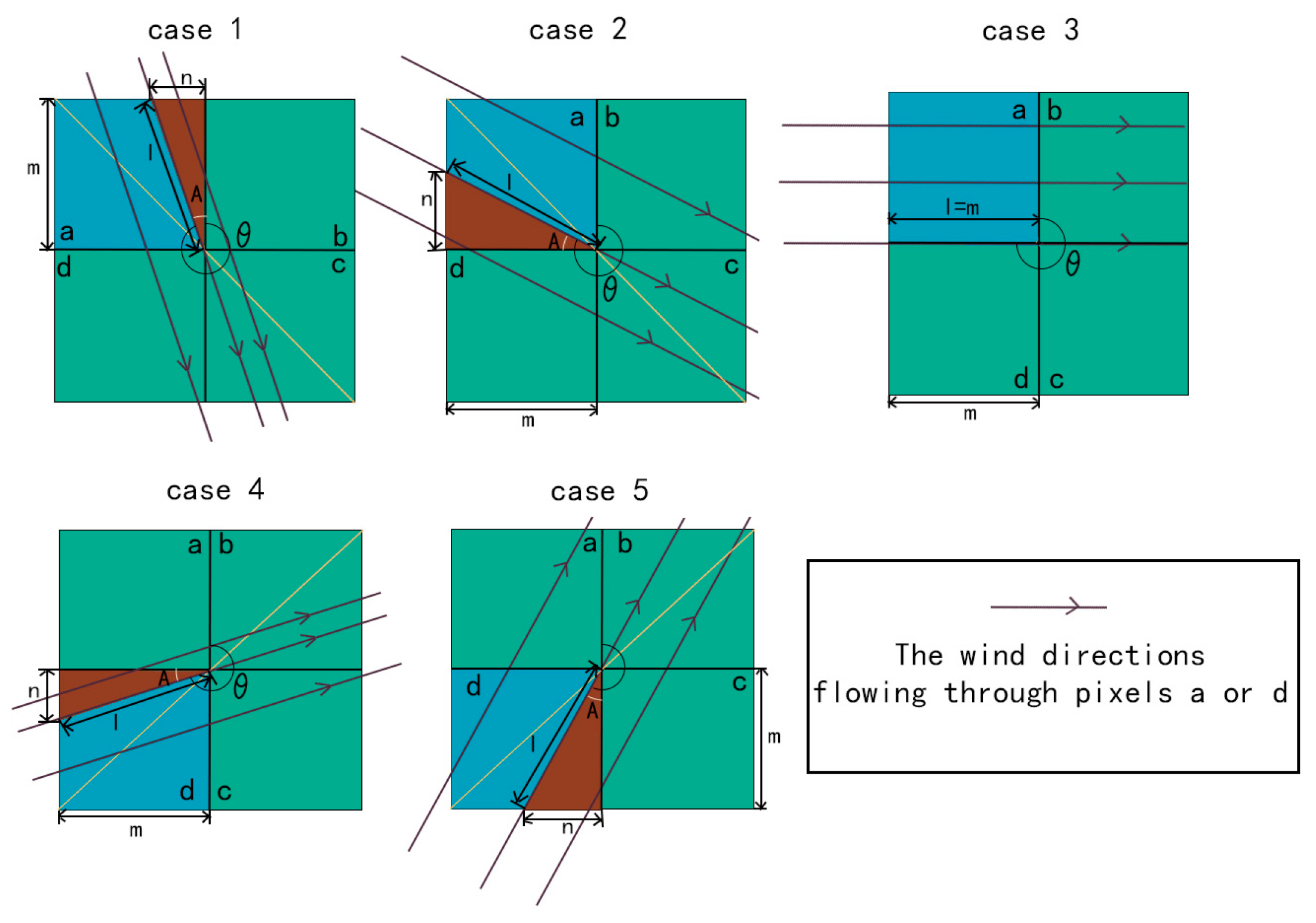


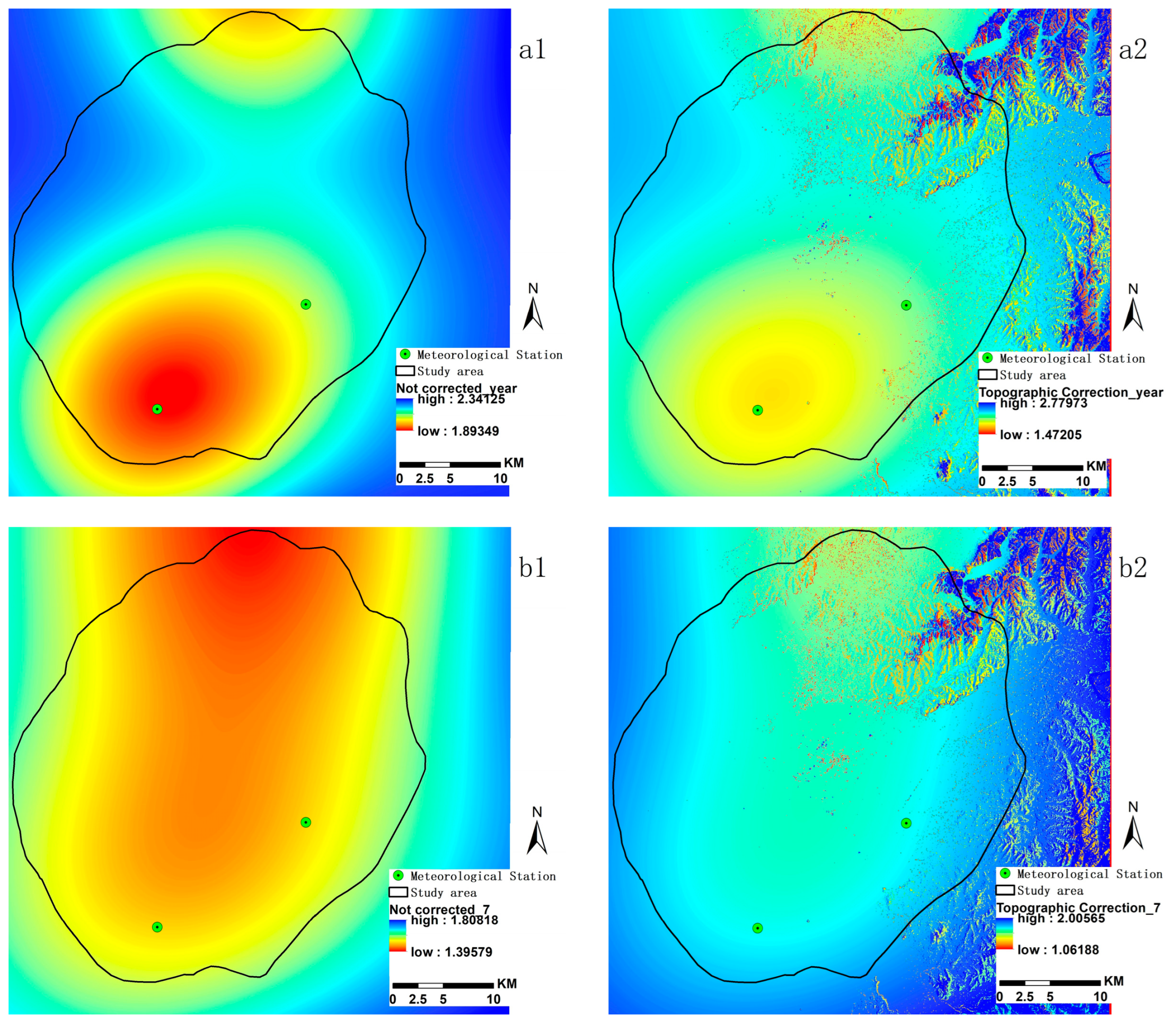
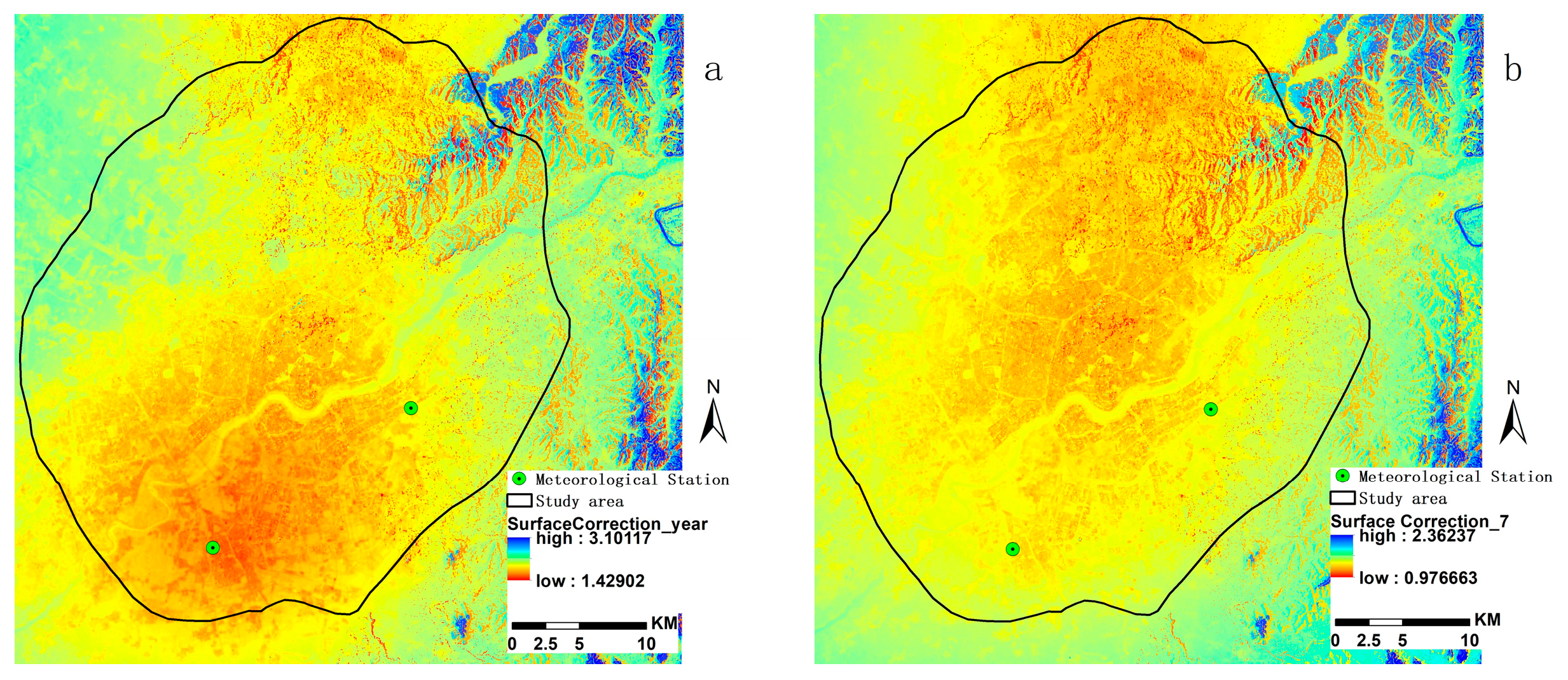

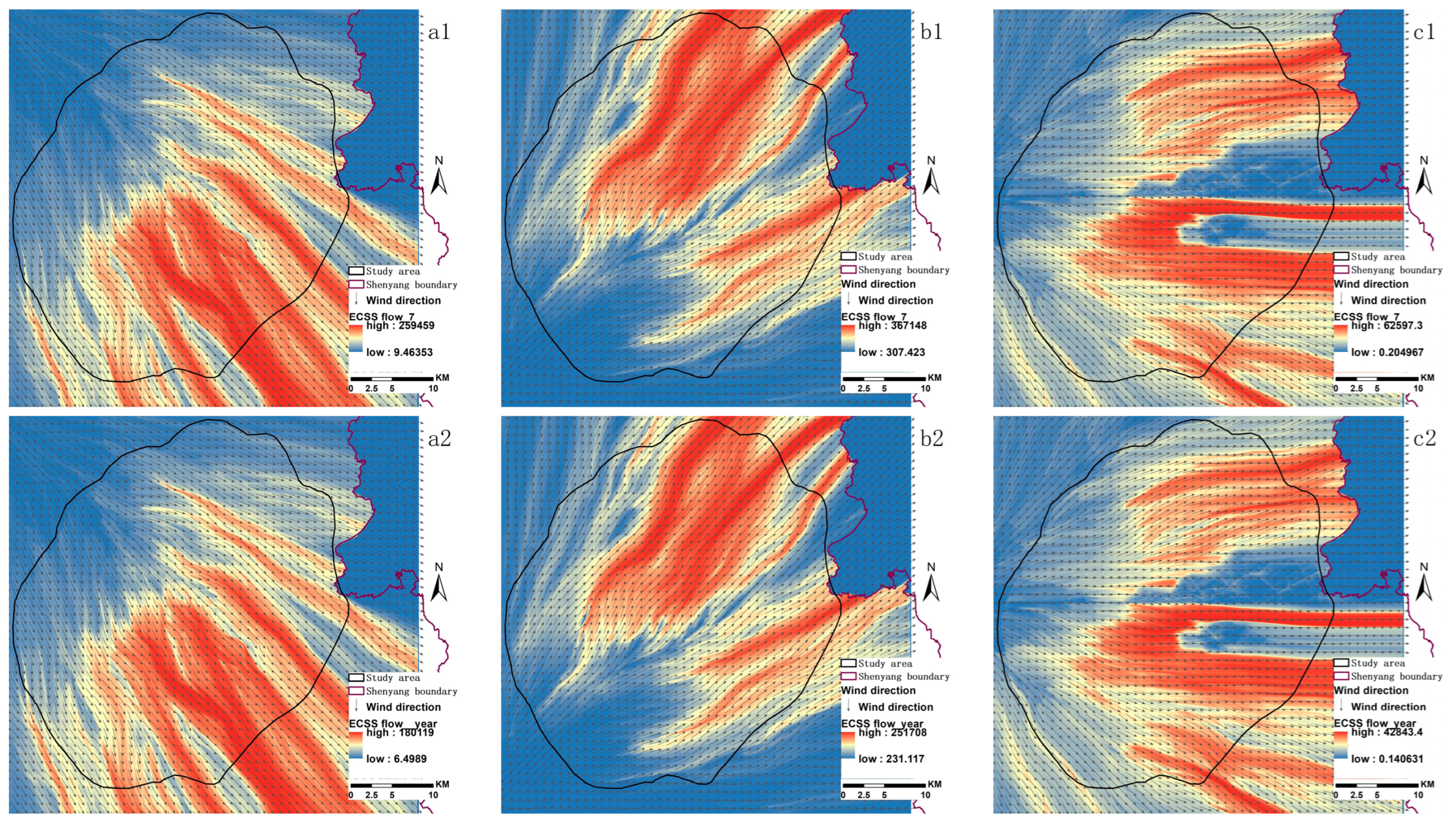

Disclaimer/Publisher’s Note: The statements, opinions and data contained in all publications are solely those of the individual author(s) and contributor(s) and not of MDPI and/or the editor(s). MDPI and/or the editor(s) disclaim responsibility for any injury to people or property resulting from any ideas, methods, instructions or products referred to in the content. |
© 2024 by the authors. Licensee MDPI, Basel, Switzerland. This article is an open access article distributed under the terms and conditions of the Creative Commons Attribution (CC BY) license (https://creativecommons.org/licenses/by/4.0/).
Share and Cite
Ma, Y.; Tian, S. Simulation of Urban Carbon Sequestration Service Flows and the Sustainability of Service Supply and Demand. Sustainability 2024, 16, 7738. https://doi.org/10.3390/su16177738
Ma Y, Tian S. Simulation of Urban Carbon Sequestration Service Flows and the Sustainability of Service Supply and Demand. Sustainability. 2024; 16(17):7738. https://doi.org/10.3390/su16177738
Chicago/Turabian StyleMa, Yaoxi, and Shufang Tian. 2024. "Simulation of Urban Carbon Sequestration Service Flows and the Sustainability of Service Supply and Demand" Sustainability 16, no. 17: 7738. https://doi.org/10.3390/su16177738
APA StyleMa, Y., & Tian, S. (2024). Simulation of Urban Carbon Sequestration Service Flows and the Sustainability of Service Supply and Demand. Sustainability, 16(17), 7738. https://doi.org/10.3390/su16177738





